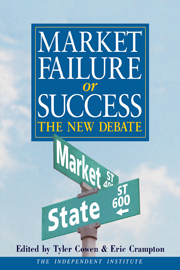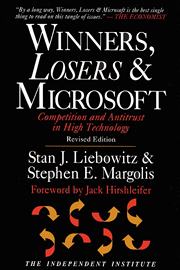“Great cases, like hard cases, make bad law,”Justice Oliver Wendell Holmes wrote in his dissent in the Northern Securities case in 1904. Inflamed passions and massive interests inevitably distort judgment and with it, the law. The Northern Securities case was the first important legal test of the antimonopoly provisions of the Sherman Antitrust Act. As Holmes noted, it presented the court with a fundamental problem—a problem that confronts antitrust law to this day: Can courts reliably distinguish efficient arrangements that foster commerce from those that impede it?
The Microsoft antitrust case, certainly one of those great cases, has not, at least up to now, given us much that is good. It has cost the taxpayers many millions of dollars, slowed the individual empowerment that the personal computer has brought, and directed great talent to politics instead of production. The great sigh of relief last Thursday, and the rise of the NASDAQ indexes, was the result of the undoing of the most damaging aspects of U.S. District Court Judge Thomas Penfield Jackson’s decision. But passions remain inflamed, the litigation will continue, and we taxpayers won’t be getting any of our money back.
But contrary to Holmes’ fear, the Microsoft case has made some good law. The U.S. Court of Appeals for the D.C. Circuit has offered an economic interpretation of existing case law on the issue of tie-in sales and explained why certain aspects of those precedents do not properly extend to new-technology goods. That interpretation provides a basis for protecting innovation in product design.
A key charge against Microsoft is that the packaging of Internet Explorer browser with the Windows operating system is an illegal tie-in sale. Tie-in sales are those that require purchasers of one good to purchase some other good as well. Certain tie-ins are illegal under provisions of the Sherman and Clayton acts.
Antitrust law labels certain kinds of conduct to be per se illegal. Price fixing is the surest and best-known example. If all the hardware stores in town get together and agree to a price on paint thinner, they violate the law, plain and simple. It doesn’t matter if the price they choose is reasonable, or if there is some compelling public interest in having a uniform price. They’ve broken the law. Per se rules are defended on the principle that simplicity and predictability of the law is desirable. Per se rules apply to behaviors that are usually harmful and seldom, if ever, beneficial.
By way of contrast, mergers often are good things, but are sometimes bad, so we apply to them not a per se rule, but instead a rule of reason. The law doesn’t condemn all mergers; it requires examination on the merits. In contrast, price fixing, which is seldom in the public interest, is always condemned: It is per se illegal. (Except when the government practices it, but that’s another essay.)
Tie-in sales are illegal—per se illegal—where (using the language of the Microsoft appeals court): “(1) the tying and tied goods are two separate products; (2) the defendant has market power in the tying product market; (3) the defendant affords consumers no choice but to purchase the tied product from it; and (4) the tying arrangement forecloses a substantial volume of commerce.”
The impasse in some important tie-in cases has been the first of these criteria. For many potential tied and tying goods, there is no problem. Printers and paper, cameras and film, tractors and fuel—all are pairs of separate goods. But in other areas, their separateness is not so clear. At issue in one important antitrust case was whether surgical services and anesthesiology are separate goods. In that case, the U.S. Supreme Court eschewed philosophical or industrial engineering inquiries in favor of a market test: Is there appreciable consumer demand to purchase the goods separately, as evidenced by the existence of markets for each of the two goods?
The D.C. Circuit had addressed this very issue for the sale of the Internet Explorer browser with the Windows operating system in its 1998 ruling regarding an earlier consent decree. The D.C. Circuit held that the operating system/browser combination constituted a legal integration of new features rather than the bundling of two separate goods. It put forward a standard that the integration escapes classification as a tie-in of two goods if it offers benefits that cannot be achieved by a consumer who purchases the two goods separately.
It was that standard that Judge Jackson addressed defiantly in his conclusions of law. In its opinion last Thursday, the D.C. Circuit took considerable care to further elaborate a rule on product integration that resolves some apparent conflicts in the existing case law and clarifies its prior decision.
The problem with the new separate-markets test articulated by the Microsoft appeals court is that it is backward looking. Technological developments often replace two separate products with one that is better than the old combination. Let’s look at an easy example.
Twenty years ago, there was a thriving industry providing after-market rust proofing for automobiles. But new cars today incorporate extensive rust proofing. Through design improvements, galvanizing, and other coatings, manufacturers have vastly improved the rust resistance of automobiles. Today consumers expect integrated rust proofing and long-term warrantees on rust resistance. Building it in simply works better than adding it on. No doubt the after-market producers that were crowded out by manufacturers’ improvements were damaged by all of this, but the benefits to consumers of integration are clear.
Software improvement has consisted largely of integration of new capabilities. We now expect file management, intuitive user interfaces, maintenance utilities, and other features in operating systems. Not long ago, each of these could be purchased separately. Word processors now include spell and grammar checkers, rudimentary drawing packages, and other features.
In this world where product definition is unsettled, the separate-markets test would label as illegal a raft of new product developments that may well be in the consumer’s interest. In such a world, the D.C. Circuit observed, the per se rule is misplaced. The separate-products test does not protect beneficial product development from the reach of antitrust law. And so, for new technologies, the appellate court abandoned the per se rule in favor of a rule of reason. Note here that the D.C. Circuit did not reverse in favor of Microsoft on this issue, but rather it remanded to the district court for reconsideration under a rule of reason analysis.
This is a new doctrine. The D.C. Circuit has not quite made new law, but it has found a basis for drawing a boundary around the old per se rule. It has done so by relying on the economics—in the new environment the benefits of the per se doctrine no longer exceed the costs.
Throughout the four years of this case, Microsoft has stubbornly adhered to one basic principle: that it has the freedom to innovate. When the D.C. Circuit decided to circumscribe the law on tie-in sales, it removed a potentially crippling impediment to product innovation. Contrary to Justice Holmes’ fear, this great case has given us some valuable guidance. For that we can thank the appeals court, and, of course, Mr. Gates’ fabled arrogance.









